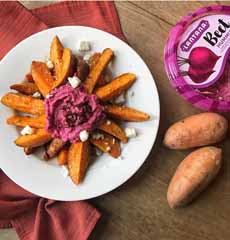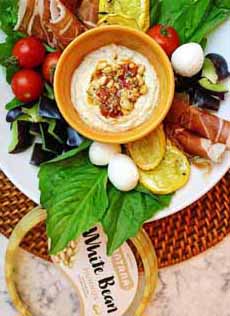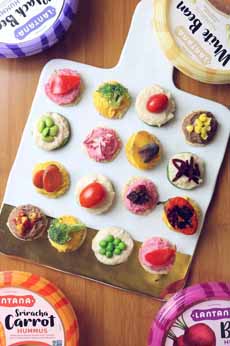TOP PICK OF THE WEEK: Lantana, The New Hummus
|
Over the past 15 years, hummus, a Middle Eastern dip and spread, has exploded as favorite food in the U.S. We think of hummus as comfort food. Based on its nutrition, versatility and of course, taste, it’s a winner. Most people know that hummus is made from cooked, mashed chickpeas blended with tahini (a paste made from toasted sesame seeds), olive oil, lemon juice, salt and often, garlic. In fact, the word hummus derives from the Arabic word for chickpeas; the name of the prepared spread is hummus bi tahina, chickpeas with tahini. What is less known is that hummus can be made with pulses—beans, lentils and peas—other than chickpeas. And that hummus doesn’t have to be beige. Lantana, a new brand of hummus made with white beans, black beans or yellow lentils instead of chickpeas, is shaking up the hummus category. In a sea of beige hummus offerings, Lantana’s hummus is green (edamame), orange (carrots, chile peppers), purple (beets), tan (black beans), yellow (yellow lentils) and other hues (the white bean hummus is beige). The flavors deliver color to the plate and excitement to the palate. We’re hooked. White no store is likely to carry all the varieties, there is a feast of flavors: Dip it and spread it, of course; but check out our 20 different ways to serve hummus beyond dipping. Lantana hummus is packaged in 10-ounce containers. For grab-and-go, there are two-ounce single-serve containers, available in multipacks or sold in individyal snack packs with crunchy sesame sticks for dipping. The line is OU-kosher and gluten free. Lantana is available nationally at retailers like Kroger, Sprouts, and Target. Here’s a store locator. Before you head to the store, print out the $1.00 coupon on the website. Purées of chickpeas, sesame, lemon, and garlic have been eaten in the Levant† for millennia. Chickpeas were widely consumed in stews and other hot dishes. Cooked, puréed chickpeas eaten cold with tahini first appear in Egypt and the Levant† during the Abbasid Caliphate (750 to 1517 C.E.) during the Islamic Golden Age. The earliest known recipes for a dish similar to hummus bi tahina are in 13th-century cookbooks from Cairo. Some food historians believe that the first hummus appeared a century earlier, attributed to Saladin, the first sultan of the Ayyubid dynasty (1174–1193). If so, it was more likely created by a cook in his kitchen, the idea of the warlord-as-cook being a stretch. |
|
|
|
Those cooks of yesteryear may not have envisioned beet hummus, carrot hummus and edamame hummus; but we’re so glad that Lantana did! ________________ †The Levant is an English term that first appeared in 1497. It originally referred to the “Mediterranean lands east of Italy.” The historical area comprises modern-day Iraq, Israel, Jordan, Lebanon, Palestine and Syria. Among other popular foods, Levantine cuisine gave birth to baklava, balafel, kebabs, mezze (including tabbouleh, hummus and baba ghanoush), pita and za’atar, among other dishes that are enjoyed in the U.S. and around the world.
|
||






